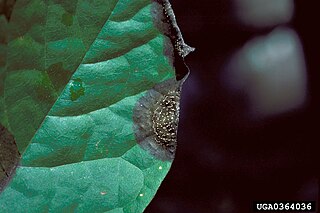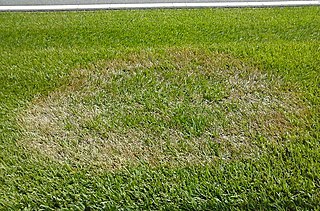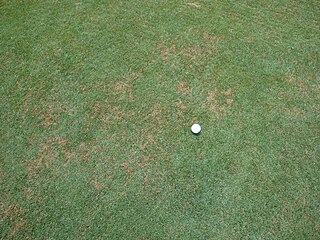
Fusarium patch is a disease in turf grass settings also called pink snow mold or Microdochium patch. Microdochium nivale is the pathogen that causes this disease in many cool season turf grass species in North America. The white-pink mycelium on infected leaf blades is a distinguishing characteristic of the Microdochium nivale pathogen. Fusarium patch is considered economically important in the turf grass industry because of its tendency to cause significant injury to golf greens, thereby decreasing putting surface quality. Dissimilar from other snow molds, such as gray snow mold, Microdochium nivale does not need snow cover to cause widespread infection.
Glomerella graminicola is an economically important crop parasite affecting both wheat and maize where it cause the plant disease Anthracnose Leaf Blight . Certain cereal varieties that have been genetically engineered. may be more susceptible to the teleomorph phase of the fungus.

Colletotrichum acutatum is a plant pathogen and endophyte. It is the organism that causes the most destructive fungal disease, anthracnose, of lupin species worldwide. It also causes the disease postbloom fruit drop on many varieties of citrus, especially Valencia and navel oranges in Florida.
Pythium volutum is a plant pathogen infecting wheat, barley, and turfgrass. It is known to be sensitive to some of the compounds typically present in selective media commonly used for isolating Pythium spp., so isolation may require alternative methods.

Typhula incarnata is a fungal plant pathogen in the family Typhulaceae.
Colletotrichum capsici is a species of fungus and plant pathogen which causes leaf blight on Chlorophytum borivilianum, basil, chickpea and pepper as well as dieback in pigeonpea and anthracnose in poinsettia.

Colletotrichum coccodes is a plant pathogen, which causes anthracnose on tomato and black dot disease of potato. Fungi survive on crop debris and disease emergence is favored by warm temperatures and wet weather.

Glomerella cingulata is a fungal plant pathogen, being the name of the sexual stage (teleomorph) while the more commonly referred to asexual stage (anamorph) is called Colletotrichum gloeosporioides. For most of this article the pathogen will be referred to as C. gloeosporioides. This pathogen is a significant problem worldwide, causing anthracnose and fruit rotting diseases on hundreds of economically important hosts.
Magnaporthe poae is an ascomycete fungus which causes the turfgrass disease commonly known as summer patch, or Poa patch. The disease occurs mostly on Kentucky bluegrass (Poa pratensis), Fescues (Festuca sp.), and on Annual bluegrass (Poa annua). Bentgrass may also become infected but shows very few symptoms and quickly recovers. Summer Patch will usually become noticeable between June and September, although small signs can appear at any time but are not noticeable because the turfgrass can recover quickly.

Brown patch is a turfgrass common fungal disease that is caused by species in the genus Rhizoctonia, usually Rhizoctonia solani. Brown patch can be found in all of the cool season turfgrasses found in the United States. Brown patch is most devastating to: Bentgrass, ryegrass, Annual bluegrass, and Tall fescue. Brown patch is also found in Kentucky bluegrass and Fine fescue but this is rare or does minimal damage. Brown patch is known as a foliar disease, so it does not have any effect on the crown or roots of the turf plant.
Pythiumdisease, also known as "Pythiumblight," "cottony blight," or "grease spot," is a highly destructive turfgrass disease caused by several different Pythium species. All naturally cultivated cool-season turfgrasses are susceptible to Pythium and if conditions are favorable to Pythium it can destroy a whole turfgrass stand in a few days or less. Pythium favors hot and very humid weather and will usually develop in low areas or swales in the turfgrass.
Red thread disease is a fungal infection found on lawns and other turfed areas. It is caused by the corticioid fungus Laetisaria fuciformis and has two separate stages. The stage that gives the infection its name is characterised by very thin, red, needle-like strands extending from the grass blade. These are stromata, which can remain viable in soil for two years. After germinating, the stromata infect grass leaf blades through their stomata. The other stage is visible as small, pink, cotton wool-like mycelium, found where the blades meet. It is common when both warmth and humidity are high.
Dollar spot is caused by the four species in the genus Clarireedia, in the family Rutstroemiaceae. The pathogen blights leaf tissues but does not affect turf grass roots or crowns. The disease is a common concern on golf course turf, but is rare in sports turf and professional landscapes. Disease symptoms commonly result in poor turf quality and appearance. The disease occurs from early spring through late fall, but is most active under conditions of high humidity and warm daytime temperatures 59–86 °F (15–30 °C) and cool nights in the spring, early summer and fall. The disease infects by producing a mycelium, which can be spread mechanically from one area to another.
Snow mold is a type of fungus and a turf disease that damages or kills grass after snow melts, typically in late winter. Its damage is usually concentrated in circles three to twelve inches in diameter, although yards may have many of these circles, sometimes to the point at which it becomes hard to differentiate between different circles. Snow mold comes in two varieties: pink or gray. While it can affect all types of grasses, Kentucky bluegrass and fescue lawns are least affected by snow mold.

Turf melting out is caused by the fungal pathogen Dreschlera poae, in the family Pleosporaceae. It is a common problem on turfgrass and affects many different species. The disease infects all parts of the plant most commonly on golf course roughs, sports fields, and home lawns. There are two stages of the disease: the leaf blade infection and the crown and root infection Melting out occurs during the cool weather of April and May and is encouraged by high nitrogen fertility. The disease is spread by wind-blown or water splashed spores and survive in thatch.

Brown ring patch is a recently described Rhizoctonia-like disease of turf grass caused by the fungus Waitea circinata var. circinata. The disease primarily affects putting greens and causes yellow or brown rings up to 1 metre (3.3 ft) in diameter. Brown ring patch was first observed in Japan and has since spread to the United States and China (2011).
Bacterial wilt of turfgrass is the only known bacterial disease of turf. The causal agent is the Gram negative bacterium Xanthomonas campestris pv. graminis. The first case of bacterial wilt of turf was reported in a cultivar of creeping bentgrass known as Toronto or C-15, which is found throughout the midwestern United States. Until the causal agent was identified in 1984, the disease was referred to simply as C-15 decline. This disease is almost exclusively found on putting greens at golf courses where extensive mowing creates wounds in the grass which the pathogen uses in order to enter the host and cause disease.
Necrotic ring spot is a common disease of turf caused by soil borne fungi that mainly infects roots (4). It is an important disease as it destroys the appearance of turfgrasses on park, playing fields and golf courses. Necrotic Ring Spot is caused by a fungal pathogen that is an ascomycete that produces ascospores in an ascocarp (6). They survive over winter, or any unfavorable condition as sclerotia. Most infection occurs in spring and fall when the temperature is about 13 to 28°C (5). The primary hosts of this disease are cool-season grasses such as Kentucky bluegrass and annual bluegrass (6). Once turf is infected with O. korrae, it kills turf roots and crowns. Symptoms of the disease are quite noticeable since they appear as large yellow ring-shaped patches of dead turf. Management of the disease is often uneasy and requires application of multiple controls. The disease can be controlled by many different kind of controls including chemicals and cultural.
Gray leaf spot (GLS) is a foliar fungal disease that affects grasses. In grasses other than maize it is caused by Pyricularia grisea, which only infects perennial ryegrass, tall fescue, and St. Augustine grass in places with warm and rainy climates.

Bitter rot of apple is a fungal disease of apple fruit that is caused by several species in the Colletotrichum acutatum and Colletotrichum gloeosporioides species complexes. It is identified by sunken circular lesions with conical intrusions into the apple flesh that appear V-shaped when the apple is cut in half through the center of the lesion. It is one of the most devastating diseases of apple fruit in regions with warm wet weather.








